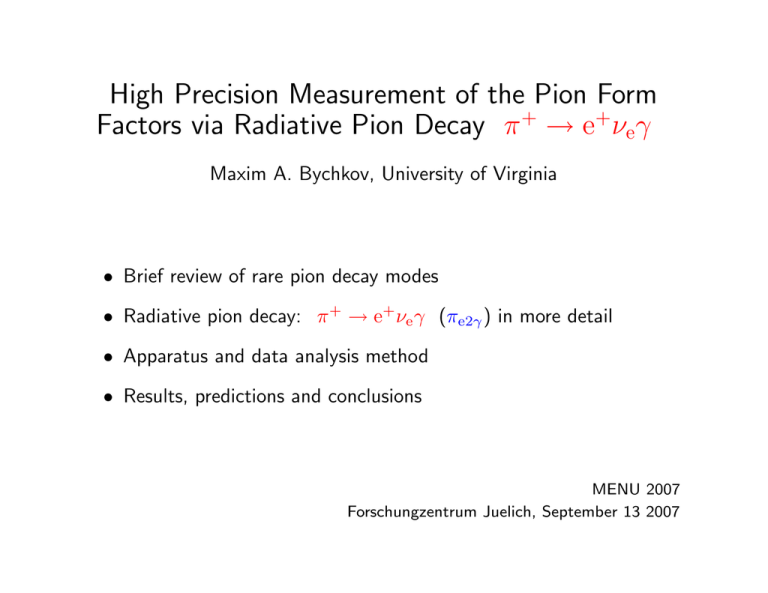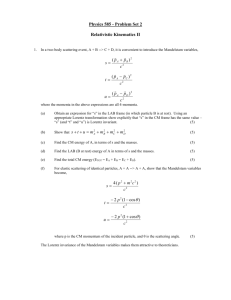High Precision Measurement of the Pion Form → e π
advertisement

High Precision Measurement of the Pion Form Factors via Radiative Pion Decay π + → e+ νe γ Maxim A. Bychkov, University of Virginia • Brief review of rare pion decay modes • Radiative pion decay: π + → e+ νe γ (πe2γ ) in more detail • Apparatus and data analysis method • Results, predictions and conclusions MENU 2007 Forschungzentrum Juelich, September 13 2007 2 Known and Measured Pion and Muon Decays (PDG 2006) Decay π + → µ+ ν 0.9998770 (4) (πµ2 ) µ+ νγ 2.00 (25) × 10−4 (πµ2γ ) e+ ν 1.230 (4) × 10−4 (πe2 ) e+ νγ 1.61 (23) × 10−7 (πe2γ ) π 0 e+ ν 1.025 (34) × 10−8 (πe3 , πβ ) e+ νe+ e− π 0 → γγ e+ e− γ B 3.2 (5) × 10−9 0.98798 (32) 1.198 (32) × 10−2 e+ e− e+ e− 3.14 (30) × 10−5 e+ e− 6.2 (5) × 10−8 X (πe2ee ) µ+ → e+ νν e+ ννγ ∼ 1.0 0.014 (4) e+ ννe+ e− 3.4 (4) × 10−5 3 Physics Goals in Radiative Pion Decay ◦ Structure of the pion by measuring pion form factors. Independent measurement of pion polarizibility αE with real photon ◦ Deviations from V − A form of Lweak by measuring absolute branching ratio ◦ Check of the CVC hypothesis by precise determination of the vector form factor FV and its momentum transfer dependence ◦ Comprehensive input to the χPT expansion coefficients 4 π → eνγ: Standard IB and V − A terms SM A tensor interaction, too? Exchange of S=0 leptoquarks P Herczeg, PRD 49 (1994) 247 5 π → eνγ: Differential Branching Ratio 2 theor d B dxdy m2π 4 m2e 2 = µ 2 2 d BIB d BSD d Bint α Bπ→eν + + = dxdy dxdy dxdy 2π FV fπ ¶2 ½ IB(x, y)+ [(1 + γ)2 SD+ (x, y) + (1 − γ)2 SD− (x, y)]+ FV + − [(1 + γ)SDint (x, y) + (1 − γ)SDint (x, y)] fπ ¾ , ± are analytical functions of where IB, SD ± , SDint x ≡ 2Eγ /mπ+ ≡ 1 − q 2 and y ≡ 2Ee /mπ+ and γ = FA /FV FA (q 2 )= FA (0) is the axial-vector form factor FV (q 2 )= FV (0)(1 + a × (1 − x)) is the vector form factor 6 1 Theoretical Description: π + → e+ νe γ Decay 1 18 15 0.9 0.1 12 0.8 0.8 0.3 9 0.6 0.7 y=2Ee/mπ y=2Ee/mπ 6 0.6 3 0.6 SD ×10 + 0.5 4 0.4 1 SD ×10 - 4 0.2 0.4 0.3 0.9 1.2 1.5 1.8 0 0.2 0.4 0.6 0.8 1 0 0.2 x=2Eγ /mπ 0.4 0.6 0.8 1 x=2Eγ /mπ 1 1 + 0.8 y=2Ee/mπ 0.8 − SD SD IB Leyenda y=2Ee/mπ 0.6 0.6 0.4 0.4 IB≈1.5 at (x,y)=(0.2,0.8) 0.2 0.2 0 0 0 0.2 0.4 0.6 x=2Eγ /mπ 0.8 1 0 0.2 0.4 0.6 0.8 x=2Eγ /mπ 1 7 Available Data on Pion Form Factors cvc |FV | = 1 α s 2~ = 0.0259(9) . πτπ0 mπ FA × 104 reference note 106 ± 60 Bolotov et al. (1990) (FT = −56 ± 17) 135 ± 16 Bay et al. (1986) 60 ± 30 Piilonen et al. (1986) 110 ± 30 Stetz et al. (1979) 116 ± 16 world average (PDG 2004) CVC relates slope a for π 0 → γγ ∗ to FV slope a = 0.041+0.004 −0.007 (Portoles, Mateu 2007) 8 π → eνγ: Pion form factors and polarizability in χPT To first order in χPT the pion weak form form factors fix: FA = 32π 2 (Lr9 + Lr10 ) , FV while the pion polarizability is given by αE = 4α r r (L + L 9 10 ) , 2 mπ F π so that αE = α FA FA −4 3 × ' 6.24 × 10 fm × . 2 2 8π mπ Fπ FV FV [To resolve Lr9 and Lr10 one needs 1 2 2 1 hrπ i = 2 Lr9 − 6 Fπ 96π 2 Fπ2 Ã ln m2π µ2 + 1 ln 2 m2K µ2 + 3 2 ! , w.a. 1.1 %; most accurate data, NA7 1986. ; last revisited at selex in 2001] 9 The PIBETA Experiment: ◦ ◦ ◦ ◦ ◦ ◦ ◦ stopped π + beam segmented active tgt. 240-det. CsI(p) calo. central tracking digitized PMT signals stable temp./humidity cosmic µ antihouse pure CsI PV π+ AC1 MWPC1 beam BC AD AC2 AT MWPC2 10 cm 10 Data Analysis Method In order to reduce the systematic uncertainties we use π + → e+ νe (πe2 ) decay for normalization: exp Bπe2γ Aπe2 × Nπe2γ = Bπe2 × Nπe2 × Aπe2γ B(A)πe2 is branching ratio (acceptance) of π + → e+ νe decay Nπe2γ is the number of the detected πe2γ events Aπe2γ is the acceptance of the πe2γ decay 11 Available Results: π + → e+ νe Decay Marciano and Sirlin, [PRL 71 (1993) 3629]: Γ(π → eν̄(γ)) = (1.2352 ± 0.0005) × 10−4 Γ(π → µν̄(γ)) calc Cirigliano and Rosell, [hep-ph/07073439v1 (2007)]: Γ(π → eν̄(γ)) = (1.2352 ± 0.0001) × 10−4 Γ(π → µν̄(γ)) calc Decker and Finkemeier, [NP B 438 (1995) 17]: Γ(π → eν̄(γ)) = (1.2356 ± 0.0001) × 10−4 Γ(π → µν̄(γ)) calc Experiment, world average (PDG 2006): Γ(π → eν̄(γ)) = (1.230 ± 0.004) × 10−4 Γ(π → µν̄(γ)) exp 12 Data Analysis: π + → e+ νe Number of Events 25000 • 20000 π→eν Simulation Measurement 15000 10000 5000 0 45 50 55 60 65 Positron Energy (MeV) Number of Events π → eν + 10 background µ -50 75 Measurement Monte Carlo 4 10 3 70 π SUM µp 0 50 tCsI - tπ-gate (ns) 100 150 13 Data Analysis Method: π + → e+ νe γ π →e νeγ Region A + + Θeγ=180 A Ee+ >50 MeV Eγ >50 MeV Θe+γ >40o 0 Θeγ=180 0 π →e νeγ Region B + B 0 + ⊗ ⊗ C 0 1 + 1 x=2Eγ/mπ+ ⊗ SDMAX 0 z=2Eν/mπ+ Θeγ=180 y=2Ee+/mπ+ 1 0 Θeγ=0 IBMAX 0 1 1 x=2Eγ/mπ+ - ⊗ SDMAX 0 z=2Eν/mπ+ 0 2Ee+/mπ+ + y=2Ee+/mπ+ 1 ⊗ ⊗ IBMAX 0 ⊗ ⊗ Θeγ=180 0 Θeγ=0 0 Ee+ >50 MeV Eγ >10 MeV o Θe+γ >40 0 SDMAX 0 Θeγ=180 0 - IBMAX π →e νeγ Region C + Θeγ=180 SDMAX y=2Ee+/mπ+ 1 Θeγ=0 Ee+ >10 MeV Eγ >50 MeV o Θe+γ >40 0 + SDMAX 0 + 1 1 2Eγ /mπ+ x=2Eγ/mπ+ - ⊗ SDMAX z=2Eν/mπ+ 0 2Eν/mπ+ 14 Data Analysis Method: π + → e+ νe γ To extract the values of the FF’s we minimize: χ2 = X i=A,B,C (Biexp (FA , FV , a) − Bithe (FA , FV , a))2 σi2 (FA , FV , a) Both experimental and theoretical B’s depend on FA , FV , a. Region Stat. uncert. (%) Syst. uncert. (%) A 0.54 0.79 B 2.0 0.58 C 1.2 1.38 15 Data Analysis: π + → e+ νe γ 4000 Region A P/B = 73 2000 Number of events 0 -10 3000 -7.5 -5 -2.5 0 2.5 Region B 5 7.5 10 P/B = 2.2 © ©© ¼ 2000 Acc. bgr. 1000 0 -10 1500 -7.5 -5 -2.5 0 2.5 Region C 5 7.5 10 P/B = 6.6 1000 500 0 -10 -7.5 -5 -2.5 0 2.5 t(e)-t(γ) (ns) 5 7.5 10 16 Data Analysis: π + → e+ νe γ Number of events • Measurement 1500 A 1000 B 500 0 0 0.2 0.4 0.6 0.8 2 λ ≡ (2Ee/mπ)sin (Θeγ/2) 1 1.2 π → eνγ Simulation 2000 Number of events π → eνγ Simulation 2000 • Measurement 1500 A 1000 500 0 C 20 30 40 50 60 Photon Energy Eγ (MeV) 70 80 17 Results (I) 10 5 χ2 Minimization A+B+C FA=0.0119(1) 2 χ (A+B+C) 10 4 10 3 FA≈ - 0.041 10 2 2 / χ2 ≈ 880 χ+ - 10 1 -600 -400 -200 0 FA-Axial Form Factor x104 200 18 150 χ2 Contours 140 FA Form Factor x 104 130 4σ 120 2σ 110 1σ FV = 259 x 10-4 CVC 100 90 80 220 230 240 250 260 270 FV Form Factor x 104 280 290 19 Results (II) for fixed CVC value of FV = 259 × 10−4 and fixed q 2 dep. a = 0.041 improved value of FA = (119 ± 1) × 10−4 numerical value of FT = (−0.60 ± 2.78) × 10−4 ALTERNATIVELY a new exp. value of FV = (258 ± 17) × 10−4 the value of FA = (117 ± 17) × 10−4 first meas’t of q 2 dep.: a = 0.095 ± 0.058 improved limit on FT : −5.2 ≤ FT × 104 ≤ 4.0 90% CL 20 Results (III) Using fixed FV =0.0259 and a=0.041 we obtain Eemin + Eγmin (MeV) (MeV) 50 50 10 min θeγ Bexp Bthe no. of (×10−8 ) (×10−8 ) events − 2.614(21) 2.599(11) 35.9 k 50 40◦ 14.46(22) 14.45(2) 16.2 k 50 10 40◦ 37.69(46) 37.49(3) 13.3 k me 10 40◦ 73.86(54) 74.11(3) 65.5 k αE = (2.87 ± 0.10) × 10−4 fm3 τπ0 = (8.46 ± 1.11) × 10−17 s 21 Summary of Radiative Pion Decay Results • We improved the precision of pion form factors FA , FV and absolute B exp sixteen-,five- and tenfold respectively. Confirmed the sign of the ratio FA /FV . • We have determined for the first time the momentum dependence of the charged pion FF’s. • We set a new stringent limits on the tensor interaction; excellent agreement with SM. • We provided a sub-percent precision input data for the χPT. • Our radiative π results provide critical input in controlling the systematics of the approved π → eν (PEN) experiment, R-05-01. • The PEN experiment will double the R-04-01 data set on radiative π decays, with yet lower backgrounds. 22 Experiment R-04-01 (PIBETA) collaboration members: V. A. Baranov,c W. Bertl,b M. Bychkov,a Yu.M. Bystritsky,c E. Frlež,a N.V. Khomutov,c A.S. Korenchenko,c S.M. Korenchenko,c M. Korolija,f T. Kozlowski,d N.P. Kravchuk,c N.A. Kuchinsky,c D. Mzhavia,c,e D. Mekterović,a D. Počanić,a P. Robmann,g O.A. Rondon-Aramayo,a A.M. Rozhdestvensky,c T. Sakhelashvili,b S. Scheu,g V.V. Sidorkin,c U. Straumann,g I. Supek,f Z. Tsamalaidze,e A. van der Schaaf,g B. A. VanDevender,a E.P. Velicheva,c V.V. Volnykh,c and Y. Wanga a Dept of Physics, Univ of Virginia, Charlottesville, VA 22904-4714, USA b Paul c Joint Scherrer Institut, CH-5232 Villigen PSI, Switzerland Institute for Nuclear Research, RU-141980 Dubna, Russia d Institute e IHEP, Tbilisi, State University, GUS-380086 Tbilisi, Georgia f Rudjer g Physik for Nuclear Studies, PL-05-400 Swierk, Poland Bošković Institute, HR-10000 Zagreb, Croatia Institut der Universität Zürich, CH-8057 Zürich, Switzerland


